
|
| |
SHAZAM,
BATMAN & SUPERMAN
INSIDE THE
DC COMICS 1973 B-2 SUPER PAC
|
| |
| |
 |
| |


Shazam #1
Batman #247
Superman
#261

This
DC Comics Super Pac is the second compilation
from the February cover date publication cycle
for 1973, hence its code B-2, and is made up of
three titles which featured frequently and indeed
regularly in this packaged format: Shazam,
Batman and Superman.
The
first was the new old kid on the block and
launched as a title published eight times a year
- which was also the case for Batman, who had
fallen on slightly hard times in terms of sales
and also saw but eight issues published a year in
1973 (and was thus also relegated to the
"not-so-visible" middle slot of this
comic pack), whilst Superman was still a solid
monthly and as good a DC advertising branding as
ever.
A
clear-cut superhero genre pack, this was another
Super Pac which retailers could expect to sell
fairly well, with Superman not only on the cover
of his own title but also on that of the first
issue of Shazam.
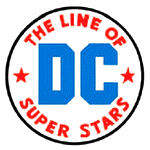
|
|
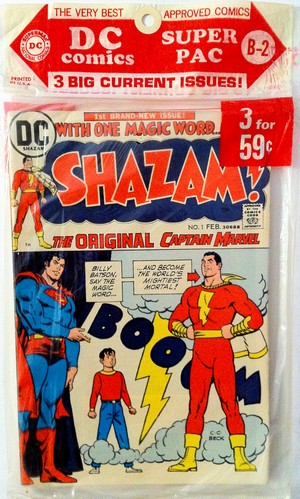 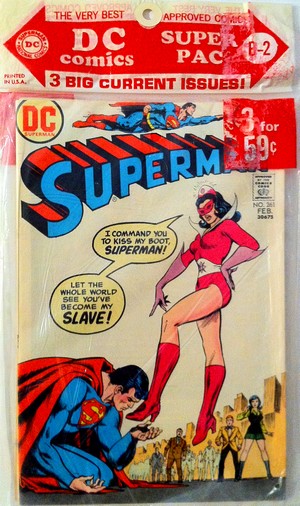
|
|
| |
|
| |
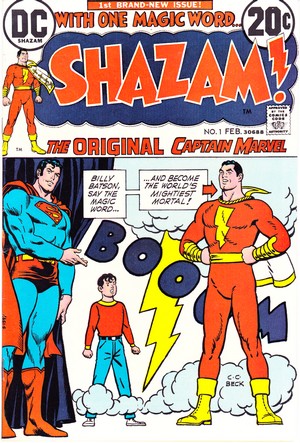
|
|
Shazam #1
February
1973
(monthly, with the
exception of January, March, July and
November)
Editor - Julius Schwartz
Cover - C. C. Beck & Nick Cardy
"... In
the Beginning ..." (6 pages)
Story - Denny O'Neil
Pencils & Inks - C. C. Beck
Letters - C. C. Beck
"The
World's Wickedest Plan" (10 pages)
Story - Denny O'Neil
Pencils & Inks - C. C. Beck
Letters - C. C. Beck
"The
Endless String !" (7,66 pages)
Story - Otto Binder
Pencils & Inks - Pete Costanza
|
|
|
| |
| Now here's
a hefty piece of comic book and comic book publishing
history. The "original Captain Marvel" (as the
cover points out) was created back in 1939 by writer Bill
Parker and artist C. C. (Charles Clarence) Beck and
originally published by Fawcett, making his debut in
February 1940 in Whiz Comics #2. He is actually
adolescent radio news reporter Billy Batson who is chosen
by an ancient wizard and given super powers to fight for
good and foil evil - Billy need only say the magic word
"Shazam!" and he is struck by magic lightning
and instantly turned into Captain Marvel. Portrayed as the world's
"mightiest mortal", Captain Marvel was given
the nickname "Big Red Cheese" by his
archvillain Doctor Sivana, and this stuck with the fans
of Captain Marvel who started labeling their hero that
way. Fawcett found that they had a real top seller on
their hands - so much so that they received a
cease-and-desist letter from National Comics Publications
(DC Comics) in June 1941, who felt that Captain Marvel
was a copyright infringement on their own Superman.
Turning into one of the longest running legal battles in
comic book publication history, DC's litigation was
initially turned down, but their appeal in 1951 prompted
Fawcett to seek an out of court agreement as the sales of
superhero comics had by that time decreased to an extent
which made it seem not worthwhile to continue fighting
DC. In 1954, Fawcett paid National $400,000 in damages
and agreed to cease publication of all Captain
Marvel-related comics - in fact the company shut down its
comic book branch entirely.
For quite some time, that
was the end of Captain Marvel. As superheroes once again
became popular, Marvel trademarked their own Captain
Marvel - which explains why DC, upon licensing the rights
to all of Fawcett's superheroes in 1972, revived Captain
Marvel in his own title but called it Shazam. As
DC had also obtained reprint rights to the original
Fawcett material they included older stories in the
title. In 1980, DC bought the rights to the Fawcett
characters outright, but Captain Marvel never returned
anywhere near to the level to the success of the 1940s -
hampered on one hand by the fact that DC could not fully
promote him as Captain Marvel (as Marvel by now owned
that copyright and tightly kept on to it), and on the
other by the fact that the Big Red Cheese was hard to
transfer. The nostalgic approach taken by DC with Shazam
highlighted the character's Golden Age goofy traits way
too much (the title ended in 1978 after 35 issues), and
later attempts to modernize the character ran afoul right
off the bat due to his inherent cheesy characteristics.
Shazam #1? Today
the owner of DC's B-2 Super Pac from 1973 can appreciate
the history this comic book issue represents. But even as
a pre-teen comic book reader back in the days I might only
just have swallowed the sanitized lameness of this
comic book, which retells Captain Marvel's origin (first
story) and then shows him escape from the trap that Dr
Sivana had created which caused the Marvel Family (an
aggregation of Fawcett characters created in the vein of
Captain Marvel) to be placed in suspended animation for
20 years (and in what looks like a chewing gum bubble in
outer space). But now, Captain Marvel returns to Earth -
all of which is rounded off by a reprint story from Captain
Marvel Adventures #55, originally published in March
1946.
It is obvious why this comic
book was placed facing outwards - DC wanted to push this
new title as much and just about everywhere they could,
which also explains the inclusion of Superman on the
cover - which is almost ironic, given the history of the
copyright litigation (the issue does contain a page of
text on certain aspects of the character's history, but
the legal issues remain unmentioned). The stories are
clearly written tongue in cheek by O'Neil, but even with
the odd nice one-liner they come across as being very
simplistic indeed - as is the artwork, although that is
intentionally so, replicating the original style (which
makes sense, having one of the original pencillers and
inkers is on board).
|
| |
|
| |
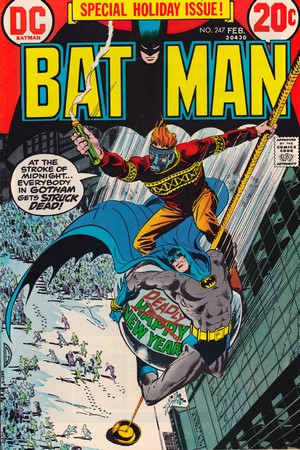
|
|
Batman
#247
February
1973
Monthly (with
the exception of January, March,
July and November)
Editor -
Julius Schwartz
Cover - Dick Giordano
"Merry
Christmas" (6 pages)
Story -
Dennis O'Neil
Pencils - Irv Novick
Inks - Dick Giordano
"...
And A
Deadly New Year!" (17,5 pages)
Story -
Dennis O'Neil
Pencils & Inks - Dick
Giordano
In this
"Special Holiday Issue"
(which although cover dated
February 1973 actually went on
sale in mid-December 1972, as did
all issues contained in this
Super Pac) Batman gets all the
pages to himself, meaning that
the usual backup feature Robin
takes a break.
|
|
|
|
| |
| Actually forming one story
taking place between Christmas Eve and New Year's Eve,
the first part covers events taking place during holy
night, when a couple with a small boy (not quite Joseph
and Mary, but close) whose car broke down in the swirling
snow seek refuge in a lonely house only to find that
they, along with the houseowner, are now at the mercy of
a gun-wielding gangster who has stolen a vial of
immensely potent nerve gas from the Army and is intent on
killing his captives. However, the Batman intervenes,
although he only gets the upper hand thanks to a bright
Christmas star which distracts the hood. The second part
shows the gangster freed by his gang en route as the
Batman intend to drive him to Police HQ. Things only get
worse after that as Commissioner Gordon informs the
Darknight Detective about a threat he has received that
Gotham will be sbjected to a nerve gas attack at the
stroke of midnight on New Year's Eve unless an imprisoned
mob primo is released. Unfortunately, said
mobster died of a heart attack in prison a few days back,
so Batman and Robin must learn the location of that
canister of nerve and find the evildoer behind the
scheme. In spite of having almost no clues and only a few
days left, the Batman finally succeeds in averting the
catastropy with only seconds to spare, using a ruse to
make the perpetrator give himself away at the New Year's
Eve party of Gotham's rich and famous. Quite often, the middle comic book in
a DC Super Pac - which was the "hidden" or even
"surprise" title - proves to be a hidden gem,
at least from today's perspective. In this case, Batman
#247 is nothing short of being the saving grace for the
1973 B-2 Super Pac. Even though this is not Dennis
O'Neil's strongest Batman plotting, it is more than solid
enough to stand way above the other two titles in this
collection (even though Shazam #1 comes from the
same pen - just shows how much a strong central character
can do). Certainly helped by engaging and vibrant pencils
from Irv Novick and Dick Giordano, this is a nice little
Christmas tale involving the Dynamic Duo. Much as I would
have been disappointed by the other two comic books in
this Super Pac back in the days, I would have absolutely
loved Batman #247. And even today, it feels
special to read this comic book fresh out of a comic
pack. Evidentally stored in places which were rather on
the warm side, all the pages in their entirety have taken
on a slight browning hue, but that is nothing compared to
finding pages still clinging together (due to the small
indentations made by the printing press at the bottom of
the pages as the paper was transported through the
machine) and now separated for the first time since that
comic book came off the press. Such is the beauty of the
time capsule known as comic pack.
The only slightly off thing
about this comic book is a full page commercial for
Kenner's "Easy-Bake Ovens" which, as
the five panel comics-like story showing "Sally's
visit to the Easy-Bake Oven toy factory"
informs us, is "the greatest girl's toy since
dolls". That ad seems strangely out of key in a
Batman comic book. However, it would not have been quite
as much out of place in the third comic book in this
Super Pac, which is:
|
| |
|
| |
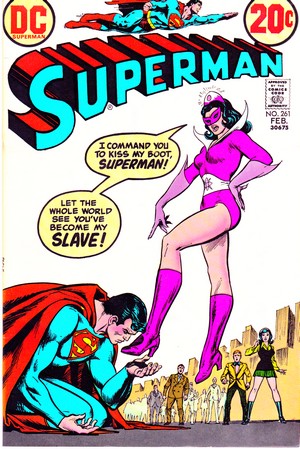
|
|
Superman
#261
February
1973
(monthly)
Editors -
Carmine Infantino & Julius
Schwartz
Cover - Nick Cardy
"Slave
Of Star Sapphire !" (24
pages)
Story - Curt
Bates
Pencils - Curt Swan
Inks - Murphy Anderson
Carol Ferris,
who "sometimes is
possessed by an uncontrollable
urge to become Star Sapphire, a
vengeful fearsome queen with a
fantastic jewel that endows her
with nightmarish power..."
suffers from a hallucination
which makes her believe Superman
killed Green Lantern - the man
Star Sapphire adores and would
want at her side as her king
(plans which GL has never been
partial to). Ferris, turning into
the astral queen "of an
alien race of female
warriors" attacks
Superman and succeeds in
controlling his mind.
|
|
|
|
| |
| Ultimately, however, Lois
Lane tricks Star Sapphire, who loses her grip on the Man
of Steel and decides it's time to make an exit. Lois
worries about what Clark will say if he finds out about
her being in costume. Superman assures her “I
promise, Lois…he’ll never hear it from
me!” Seemingly,
the DC Universe is populated by a number of Star
Sapphires, the first of which made her first apperance in
All-Flash Comics #32 in December 1947, battling
the Golden Age Flash. Carol Ferris first appeared in
October 1959 in Showcase #22, and her Star
Sapphire incarnation premiered in Green Lantern
#16 in October 1962. Her appeareance in Superman
#261, however, is highly contrived and kicks off a story
that feels rather anaemic and quite harmless - which
really is quite amazing given the cover... or is that
cover a case of honi soit qui mal y pense ?
Obviously as much a matter
of taste as any other superhero, the Superman stories
from the early 1970s frequently came across as rather
ludicrous to anyone who wasn't a die-hard fan. The howler
in this issue is when the Man from Krypton uses super-ventriloquism
to alert Lois lane in her office to the predicament of
Superman at the hands of Star Sapphire - which makes you
wonder if nobody other than yourself was wondering why on
earth he didn't just use super-telepathy ...
The artwork by Swan and
Anderson is clean and sharp, and all in all makes a so-so
story look way better than it actually is.
|
| |
|
| |

More on comic
packs
|
| |
|
| |

|
| |
First
posted 6 July 2014
Text
is (c) 2014 atw
The illustrations presented here are copyright material.
Their reproduction in this non-commercial context is
considered to be fair use.
|